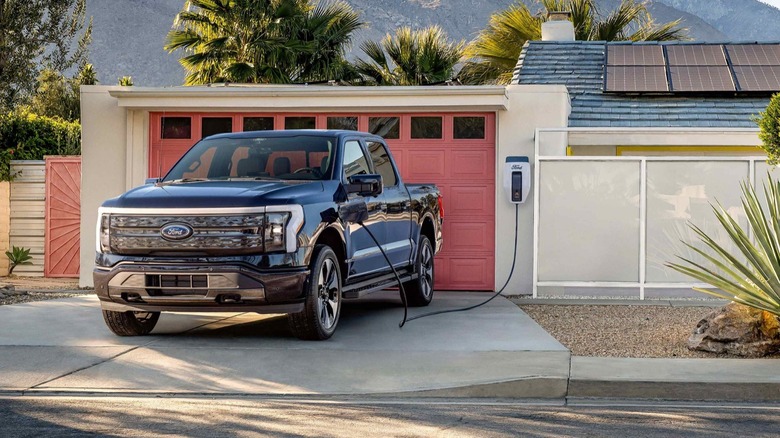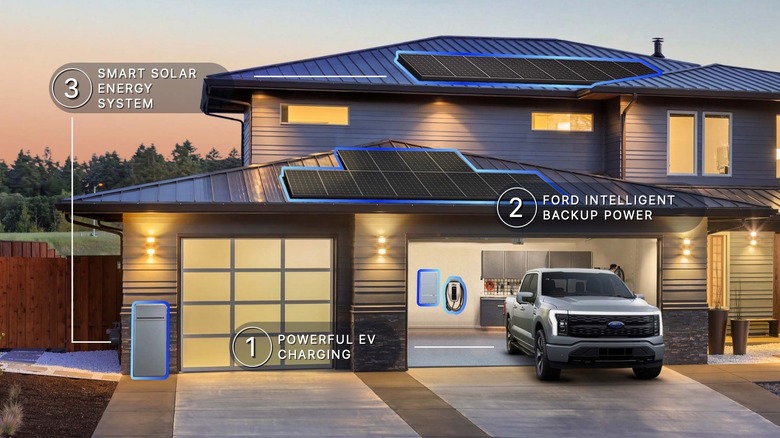PG&E Will Tap The Ford F-150 Lightning's Most Compelling Feature
Ford's F-150 Lighting will be the EV at the heart of a new pilot between the automaker and power supplier PG&E, the second bidirectional study to be announced this week that will be carried out in California homes. The pilot will explore how using the all-electric pickup truck – deliveries of which are expected to begin later in 2022 – as a backup battery during grid outages can be better integrated with PG&E's infrastructure and services.
It comes only days after PG&E announced a pilot with General Motors, which will see trial installations of custom bidirectional charging hardware installed in PG&E customers' homes in California by the end of this year. For that to operate, GM will be adding bidirectional support to its electric vehicles, including both those based on the existing platform underpinning models like the Chevrolet Bolt EUV, and those on the upcoming Ultium platform from Cadillac, GMC, and other marques.
"As more electric vehicles and new charging technology become available, it is critical that we better understand how EVs can interact with the electric grid and how we can best support our customers," Patti Poppe, PG&E Corporation CEO, said of the collaboration.
Ford was already ahead of the pack on bidirectional charging
Ford was already supporting bidirectional power on the F-150 Lightning, of course, making the technology one of the headline features of the EV pickup when it was announced. Supported by a specially-designed 80A wall charger that Ford will bundle with select F-150 Lightning trims, and offer as an option with others, it will allow the truck to power a home in the case of an outage. Should the grid power shut off, for whatever reason, the charger will automatically switch over to the truck's battery; when the grid power is restored, the system will revert to normal, and begin charging the EV again.
Owners of the system won't need to have PG&E as their electricity supplier in order for it to operate, and Ford has already announced that it is partnering with Sunrun in most – though not all – of the US states for installation. That could, optionally, include a solar panel system too, for using free solar energy to assist in recharging the F-150 Lightning, including when it's being used as the home's power supply.
What PG&E and Ford's pilot will explore, however, is how bidirectional charging in this way could better interconnect with the electric grid. Exact details on that haven't been shared yet, though PG&E says that will include "how it can support customer resiliency during grid outages." In addition, PG&E will use the pilot to look at how the overall customer experience plays out, in the expectation that bidirectional charging will become more prevalent in the years ahead.
Handling outages is just the start
Ford has predicted that the F-150 Lightning could potentially power the typical US home for up to 10 days in the case of an extended outage, though that assumes some rationing of electricity use during that period. Even with more typical use, though, the truck's battery could feasibly last for three days or more.
While outages are one obvious application for bidirectional charging, PG&E has also said that it is looking at how the technology could be applied at other times. One use that Ford has signaled is coming later to the F-150 Lightning is the ability to use the truck's battery as a temporary power source when electricity from the grid is relatively inexpensive. Then, when rates rise, the home could switch to using that banked power, avoiding the higher costs in the process.
Another possibility is more broadly controlled switching, where PG&E or other power companies could shift homes to EV battery power so as to help avoid – or mitigate – rolling outages. California last saw those in 2020, as the state attempted to deal with over-demand for electricity that the grid simply could not satisfy. With such rolling outages typically lasting around two hours, switching to the F-150 Lighting instead would involve a minimal hit on the truck's own power levels, though Ford has built in controls that allow owners to limit how low the battery in the EV can go while it's being used as a temporary power supply.


